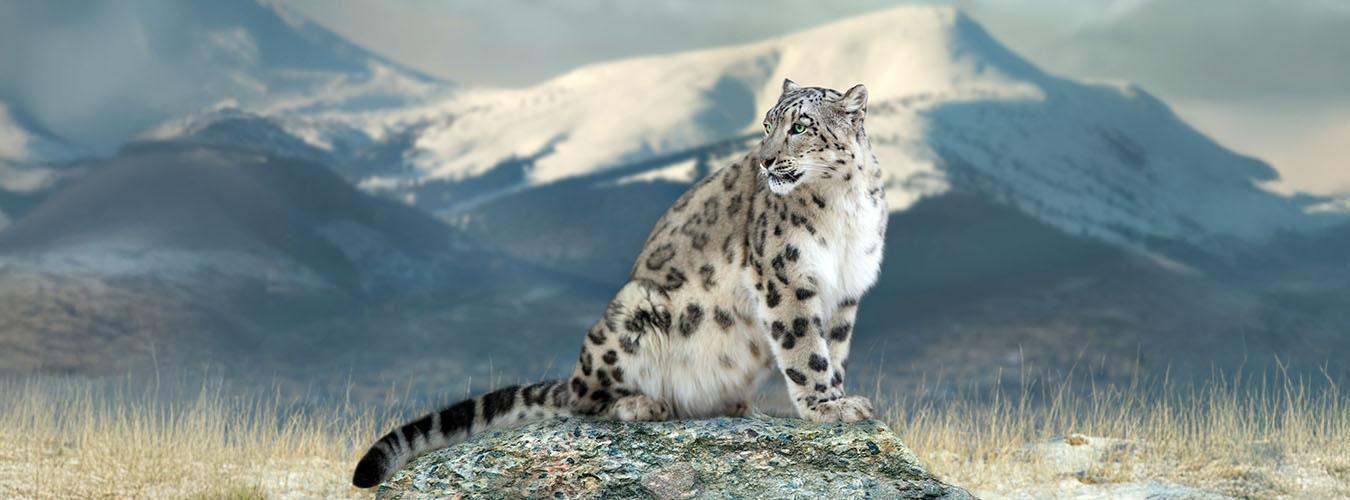On October 23, the international community celebrates International Snow Leopard Day — one of the rarest and most elusive members of the cat family. The UN General Assembly proclaimed this date in 2024 to strengthen international cooperation in protecting the snow leopard and its mountain ecosystems.
Ghost of the Mountains
The snow leopard (Panthera uncia) is often called the "ghost of the mountains" due to its ability to blend seamlessly with high-altitude snowy landscapes. This majestic predator inhabits the mountains of twelve Asian countries: Afghanistan, Bhutan, India, Kazakhstan, China, Kyrgyzstan, Mongolia, Nepal, Pakistan, Russia, Tajikistan, and Uzbekistan.
In 2017, the snow leopard population was classified by the International Union for Conservation of Nature as "vulnerable," meaning the species faces a high risk of extinction in the wild in the medium term. Since 1975, the snow leopard has been listed in Appendix I of the Convention on International Trade in Endangered Species of Wild Fauna and Flora.
Threats to Survival
The greatest dangers to the snow leopard are habitat loss and fragmentation, depletion of prey base, illegal trade and poaching, as well as climate change. These factors require urgent and coordinated action from the international community.
Ecosystem Significance
Mountain ecosystems provide water resources to a significant portion of the world's population. The snow leopard, as a key predator, plays an important role in maintaining the balance of these ecosystems. Its conservation is directly linked to achieving the UN Sustainable Development Goals, including ensuring access to clean water (SDG 6), combating climate change (SDG 13), and protecting biodiversity (SDG 15).
International Cooperation
Range countries are actively working on snow leopard protection through regional initiatives. These include the Global Snow Leopard and Ecosystem Protection Program, the 2017 Bishkek Declaration signed by 12 countries, and the 2024 Samarkand Resolution on snow leopard conservation and climate adaptation.
Important steps include establishing breeding programs, developing national action plans, and transboundary approaches to protecting snow leopard habitats. Initiatives such as the Memorandum of Understanding among Kazakhstan, Kyrgyzstan, Tajikistan, and Uzbekistan demonstrate the region's commitment to preserving this unique species.
International Snow Leopard Day calls on everyone to recognize the importance of protecting mountain ecosystems and our planet's biodiversity. Conserving the "ghost of the mountains" is not only about protecting a specific species, but also an investment in the ecological future of all humanity.
Keywords
International Snow Leopard Day, October 23, snow leopard, Panthera uncia, ghost of the mountains, wildlife conservation, endangered species, mountain ecosystems, biodiversity, vulnerable species, CITES Convention, climate change, sustainable development, Bishkek Declaration, Global Snow Leopard and Ecosystem Protection Program
Ghost of the Mountains
The snow leopard (Panthera uncia) is often called the "ghost of the mountains" due to its ability to blend seamlessly with high-altitude snowy landscapes. This majestic predator inhabits the mountains of twelve Asian countries: Afghanistan, Bhutan, India, Kazakhstan, China, Kyrgyzstan, Mongolia, Nepal, Pakistan, Russia, Tajikistan, and Uzbekistan.
In 2017, the snow leopard population was classified by the International Union for Conservation of Nature as "vulnerable," meaning the species faces a high risk of extinction in the wild in the medium term. Since 1975, the snow leopard has been listed in Appendix I of the Convention on International Trade in Endangered Species of Wild Fauna and Flora.
Threats to Survival
The greatest dangers to the snow leopard are habitat loss and fragmentation, depletion of prey base, illegal trade and poaching, as well as climate change. These factors require urgent and coordinated action from the international community.
Ecosystem Significance
Mountain ecosystems provide water resources to a significant portion of the world's population. The snow leopard, as a key predator, plays an important role in maintaining the balance of these ecosystems. Its conservation is directly linked to achieving the UN Sustainable Development Goals, including ensuring access to clean water (SDG 6), combating climate change (SDG 13), and protecting biodiversity (SDG 15).
International Cooperation
Range countries are actively working on snow leopard protection through regional initiatives. These include the Global Snow Leopard and Ecosystem Protection Program, the 2017 Bishkek Declaration signed by 12 countries, and the 2024 Samarkand Resolution on snow leopard conservation and climate adaptation.
Important steps include establishing breeding programs, developing national action plans, and transboundary approaches to protecting snow leopard habitats. Initiatives such as the Memorandum of Understanding among Kazakhstan, Kyrgyzstan, Tajikistan, and Uzbekistan demonstrate the region's commitment to preserving this unique species.
International Snow Leopard Day calls on everyone to recognize the importance of protecting mountain ecosystems and our planet's biodiversity. Conserving the "ghost of the mountains" is not only about protecting a specific species, but also an investment in the ecological future of all humanity.
Keywords
International Snow Leopard Day, October 23, snow leopard, Panthera uncia, ghost of the mountains, wildlife conservation, endangered species, mountain ecosystems, biodiversity, vulnerable species, CITES Convention, climate change, sustainable development, Bishkek Declaration, Global Snow Leopard and Ecosystem Protection Program
